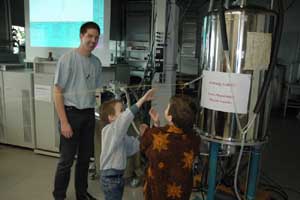By Michael Schlumpf
Following four colour-coded routes, visitors of all ages made their way through labs of the departments of Materials Science and Chemistry and through the institutes of Pharmaceutical Sciences and Microbiology. Tracking down matter, molecules, medicine and microbes did not only involve the visitors in looking but also in experimentation. Using graphic examples researchers showed how they work in a way that was easy for non-experts too to understand. While adults were mostly interested in listening to lectures, hands-on experimentation was uppermost for the children.
Visitors found their way through the labs by following coloured arrows that mapped out the route to the next station. The red route of the molecules was long and led via numerous staircases and all floors through the first two fingers of the HCI building. With the help of "stereo specs" and computer monitors young and old made themselves more familiar with the appearance of prions, found out what kinds of trace elements Lake Zurich has had to absorb over the past hundred years or how X-rays can help to analyse the structure of crystals in atomic resolution. In a hands-on experiment they were able to weigh themselves in the same way in which a molecular mass is determined by means of a mass analysis with flight-time mass spectrometry. On a small vehicle those who wished to were able to ascertain that the lighter they were, the quicker they moved. The same phenomenon applies to molecules: the quicker the flight, the lighter the molecule.
On other tours, for example, visitors were able to look into a raster electron microscope, and see for themselves what the facetted eye of a fly looked like under high resolution, or how an artificial tooth is made from ceramic powder or how legionella from the air get into the lungs. And wherever one looked, one saw children fully engrossed in what they were busy with: cooking slimy on the materials tour and making their own sun-blocking lip gloss in the Institute of Pharmaceutical Sciences.
The open-door days on campus Hönggerberg were a real adventure. Rarely has science presented itself to a wide public in such a graphic way as it did during this weekend. For once, very complex subjects were transformed into phenomena that anyone who was interested could experience and comprehend, and the connections of which were brought home by the researchers' supplementary explanations.
 |
Visitors following a talk in a lab on the production of antibodies, which selectively concentrate on tumorous blood vessels. large
|
 |
Children experiencing the power of a strong magnetic field. large
|
